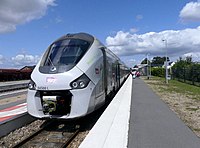
Photo from wikipedia
Microalgae are a potential source of numerous nutritional products and biofuels. Their applications range from the food industry to the medical and fuel sectors and beyond. Recently, the conversion of… Click to show full abstract
Microalgae are a potential source of numerous nutritional products and biofuels. Their applications range from the food industry to the medical and fuel sectors and beyond. Recently, the conversion of biomass into biodiesel and other biofuels has received a lot of positive attention within the fossil fuel arena. The objective of biorefineries is to focus on utilising biomass efficiently to produce quality biofuel products by minimising the input as well as to reduce the use of chemical or thermal pre-treatments. Pre-treatment processes in biorefineries involve cell disruption to obtain lipids. Cell disruption is a crucial part of bioconversion, as the structure and nature of microalgae cell walls are complex. In recent years, many research papers have shown various pre-treatment methods and their advantages. The objective of this paper was to provide a comprehensive in-depth review of various recent pre-treatment techniques that have been used for microalgal biodiesel production and to discuss their advantages, disadvantages, and how they are applied in algal biorefineries.
Journal Title: Sustainability
Year Published: 2022
Link to full text (if available)
Share on Social Media: Sign Up to like & get
recommendations!